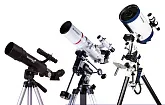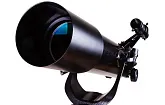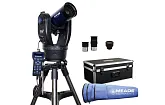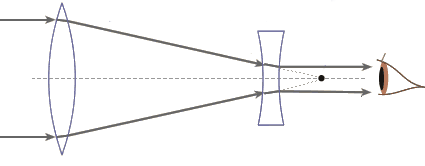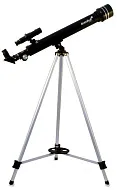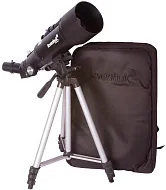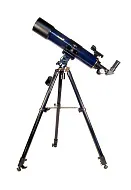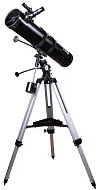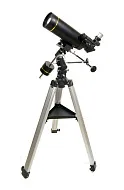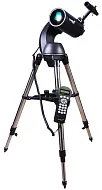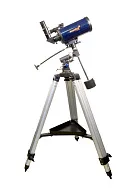How to choose a telescope
All optical telescopes can be divided by the type of the main light-gathering element into refracting, reflecting and catadioptric – mirror-lens telescopes. All designs have advantages and disadvantages. When you choose a design, you need to take several factors into account – the purpose of observation, conditions, transportability and weight, level of aberrations, price, etc. To make the process of choosing a telescope easier, we will tell you about the characteristics of the most popular types of telescopes today.
Refractors
Refracting telescopes were the first telescopes in history. The biconvex lens stands for an objective lens and collects light in this telescope. Its function is based on the property of the convex lenses to refract light rays and collect them in a certain point - the focus. Therefore, refracting telescopes are often called refractors (from Latin refract “to break”).
In the Galileo telescope (created in 1609), two lenses were used in order to collect the maximum amount of stellar light and to allow the human eye to see it. The first lens (the objective lens) is convergent; it collects light and focuses it at a certain distance, and the second lens (the eyepiece) is divergent; it converts the converging bundle back into the parallel one. Galileo’s design transmits a direct, undistorted image, but suffers greatly from chromatic aberration, which spoils the image. Chromatic aberration comes as a false coloration of the boundaries and details of the object.
The Keplerian telescope (invented in 1611) was more complicated and had a convex lens for an eyepiece, the front focus of which was combined with the rear focus of the objective lens. The image was inverted, but this is not significant for astronomical observations - you can place a measuring grid at the focal point inside the tube. The design proposed by Kepler had a strong influence on the development of refractors. While it also had chromatic aberration, its effect could be reduced by increasing the focal length of the objective lens. Therefore, refractors of the time, with modest lens diameters, often had a focal length of several meters and a corresponding tube length. Some refractors could even do without it (the observer held an eyepiece and “caught” an image that was transmitted by the objective lens installed on a special tripod).
Because of these specific features of the refractors, even Newton came to the conclusion that it was impossible to correct chromatic aberration of the refractors. But in the first half of the 18th century an achromatic refractor appeared.
Two-lens achromatic refractors are the most common tools among amateur instruments, but there are also more complex lens designs. Usually the objective lens of the achromatic refractor consists of two lenses made of different types of glass: one lens is converging and the other is diverging. This allows for significant reduction of spherical and chromatic aberrations (the image distortions inherent in a single lens). At this point, the telescope tube remains relatively small.
Further development of the refractors led to the invention of apochromates, in which the effect of chromatic aberration on the image is reduced to an almost invisible value. This, however, is achieved by the use of special types of glass that are expensive in production and processing. Therefore, the price for such refractors is several times higher than for apochromates with the same aperture.
Like any other optical design, the refractors have their advantages and disadvantages, the analysis of which will help you choose a telescope.
Advantages of the refractors:
- comparative simplicity of the design, which ensures easy operation and reliability;
- almost does not require special equipment;
- fast thermal stabilization;
- perfect for observation of the Moon, the planets, and the twin stars – especially at high apertures;
- absence of central screening from the secondary or diagonal mirror provides a maximum contrast of the image;
- good color rendition in achromatic design and excellent color rendition in apochromatic design;
- a closed tube eliminates airflows spoiling the image and protects the optics from dust and contamination;
- the objective lens is made and adjusted by the manufacturer as a single unit and does not require any user adjustments.
Disadvantages of the refractors:
- maximum cost per unit of the lens objective in comparison with reflectors or catadioptrics;
- as a rule, refractors are heavier and larger than reflectors and catadioptrics with the same aperture;
- price and large size of the telescope restrict the maximum aperture diameter;
- less suitable for observation of the small and dim objects of deep space because of the practical restrictions to the aperture
We recommend:
Levenhuk Skyline 50x600 AZ Telescope
Levenhuk Skyline 50x600 AZ Telescope is a compact refractor perfect for entry-level astronomical observations. This model features high-quality optics, reliable construction and remarkable ease of use. With this telescope you will be able to observe lunar craters, phases of Venus, atmospheric flows of Jupiter, rings of Saturn and a large variety of other celestial objects.
Levenhuk Skyline Travel 70 Telescope
Levenhuk Skyline Travel 70 Telescope is a compact and lightweight refractor with an alt-azimuth mount. This telescope is portable: you can take it with you for observations in the countryside. It comes with a backpack where the telescope, its mount, optical accessories and a tripod perfectly fit in. This telescope is perfect for observations of the Solar System planets and the Moon. It can also be used as a spotting scope for terrestrial observations.
Levenhuk Strike 90 PLUS Telescope
Levenhuk Strike 90 PLUS is a wonderful telescope for anyone who is beginning his or her forays into celestial observations. It is indispensable for children and their parents alike on their journeys through the universe. This telescope is extremely easy to set up and use, which makes it perfect for amateur astronomers. Strike 90 PLUS lets you observe the Moon and its famous craters, the wondrous landscapes of Mars; the rings of Saturn and satellites of Jupiter, and behold distant star clusters and nebulae.
Reflectors
Reflecting telescope (from the Latin “reflectio” – to reflect) is a telescope with the lens consisting only of mirrors. Just like a convex lens, a concave mirror can collect light at some point. If you place an eyepiece at this point, you can see the image.
One of the first reflectors was the Gregorian reflector telescope (1663), named after James Gregory, who invented a telescope with a parabolic main mirror. An image observed in such a telescope is free from both spherical and chromatic aberrations. The light, collected by a large main mirror, is reflected from a small elliptical mirror fixed in front of the main one and is led out to the observer through a hole in the center of the main mirror.
Disappointed in refractors that were modern at the time, Isaac Newton began working on development of a reflecting telescope in 1667. Newton used the main metal mirror (glass mirrors with a silver or aluminum coating appeared later) to collect light, and a small flat mirror to deflect the collected optical beam at a right angle and bring it to the side of the tube into the eyepiece. It was thus possible to cope with chromatic aberration - mirrors are used instead of lenses in this telescope, and they reflect light with different wavelengths in equal measure. The main mirror of the Newtonian reflector can be parabolic or even spherical if its aperture ratio is relatively small. A spherical mirror is much easier to make, so the Newtonian reflector with a spherical mirror is one of the most affordable types of telescopes, including those requiring assembly.
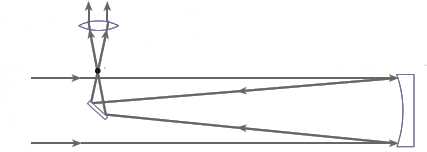
The scheme proposed in 1672 by Laurent Cassegrain resembles the Gregory reflector, but has some distinctive features – hyperbolic convex secondary mirror, and therefore, more compact size and a smaller central focus. A traditional Cassegrain reflector is not technologically feasible in mass production (sophisticated surfaces - parabola, hyperbola), and has an unimproved coma aberration. Its modifications remain popular today. In particular, in a Ritchey-Chretien telescope the main and secondary hyperbolic mirrors are used, which provides for a wide field of view with no chromatic aberrations and is especially valuable for astrophotography (the famous Hubble space telescope has a design of this kind). Besides, based on the Cassegrain reflector, popular and technologically simple catadioptric designs were developed later – Schmidt-Cassegrain and Maksutov-Cassegrain.
When you choose a telescope, you should know that today “a reflector” often refers to a telescope with a Newtonian design. With little spherical aberration and no chromatism, it is still not free from aberrations. Already near the axis, a coma (non-isoplanatism) begins to appear – an aberration associated with the unevenness of the magnification in different annular zones of the aperture. Coma leads to the fact that an image of the star does not look like a circle, but as a projection of a cone - a sharp and bright part is closer to the center of the field of view; blunt and round far from the center. The coma is directly proportional to the distance from the center of the field of view and to the square of the objective lens diameter. That is why it is especially prominent in the so-called “fast” (high-aperture) Newtonians at the edge of the field of view. To correct the coma, special lens correctors are used, which are installed in front of the eyepiece or camera.
As the most affordable reflector for self-assembly, the Newtonian is often made on a simple, compact and practical Dobsonian mount and thus becomes a portable telescope with an affordable aperture. Not only amateurs are engaged in the production of the Dobsonians, but also commercial manufacturers, and telescopes can have apertures of up to half a meter or more.
Advantages of the reflectors:
- the lowest cost per an aperture diameter unit in comparison to the refractors and catadioptrics – it is easier to make large mirrors than large lenses;
- comparatively compact and transportable (especially the Dobsonian reflectors);
- due to a comparatively large aperture, they are perfect for observing dim objects of deep space – galaxies, nebulae, and star clusters;
- transmit the bright images with little distortions, no chromatic aberration.
Disadvantages of the reflectors:
- central focus and expansion of the secondary mirror reduce the contrast of an image;
- massive glass mirror takes a lot of time for thermal stabilization;
- the open tube is open to dust and thermal air currents that spoil an image;
- from time to time, the mirrors have to be adjusted (alignment or collimation is necessary) as they lose their adjustment during transportation and use.
We recommend:
Levenhuk Skyline 130x900 EQ Telescope
Levenhuk Skyline 130x900 EQ is a Newtonian reflector, which is most suitable for the study of deep-sky objects. It is also perfect for observation of planets, even the most remote ones: Jupiter, Saturn, or asteroids and comets. NGC objects, many in high detail, are reachable as well. The telescope provides a clear and sharp image.
Levenhuk SkyMatic 135 GTA Telescope
The Levenhuk SkyMatic 135 GTA Telescope is a reflector on an azimuth mount with GoTo function. This large aperture (f/5) telescope is not only suitable for astronomical observations, but also for astrophotography. Lunar craters with a diameter of just 4.5 miles, the rings of Saturn, the seasons change on Mars, and the distant nebulae and galaxies: can all be observed in detail through this telescope. You can also watch the most striking objects from the Messier and NGC catalogues, asteroids, comets, and more.
Levenhuk Strike 120 PLUS Telescope
Levenhuk Strike 120 PLUS Telescope is a Newtonian reflector that makes an excellent choice for any beginning astronomer. The telescope features a 114-mm primary mirror diameter and a focal length of 700 mm. High-quality optics with a special coating allow you to see a large variety of astronomical objects: from lunar mountains and lunar craters with a diameter of about 3 miles to globular clusters.
Reflecting telescope (from the Latin “reflectio” – to reflect) is a telescope with the lens consisting only of mirrors. Just like a convex lens, a concave mirror can collect light at some point. If you place an eyepiece at this point, you can see the image.
One of the first reflectors was the Gregorian reflector telescope (1663), named after James Gregory, who invented a telescope with a parabolic main mirror. An image observed in such a telescope is free from both spherical and chromatic aberrations. The light, collected by a large main mirror, is reflected from a small elliptical mirror fixed in front of the main one and is led out to the observer through a hole in the center of the main mirror.
Сatadioptric telescopes use the lenses and mirrors to build an image and correct aberrations. Astronomy lovers often distinguish two types among catadioptric telescopes with a Cassegrain design – Schmidt-Cassegrain and Maksutov-Cassegrain. These are the most popular telescopes.
In Schmidt-Cassegrain telescopes (Sch-C), the main and secondary mirrors are spherical. The spherical aberration is corrected by the full-aperture correction Schmidt plate placed at the nose tube. This plate seems flat from the outside, but has a complex surface, and creating the surface is the main difficulty of manufacturing the design. However, American companies Meade and Celestron have successfully mastered the production of the Sch-C design. Among the residual aberrations of this design, the field curvature and the coma are the most noticeable, correction of which requires the use of lens correctors, especially for taking pictures. The main advantages are a short tube and a lower weight than a Newtonian reflector of the same aperture and focal length. At the same time, there are no extensions from fixing the secondary mirror, and the closed tube prevents formation of air currents and protects the optics from dust.
The Maksutov-Cassegrain (M-C) design was developed by the Soviet optician Dmitry Maksutov and, similarly to Sch-C, has spherical mirrors. A full-aperture lens corrector – the meniscus (convex-concave lens) – is used to correct aberrations. Therefore, such telescopes are also called meniscus reflectors. A closed tube and the absence of extensions are also advantages of M-C. You can correct almost all aberrations by selecting the design parameters. The exception is the so-called spherical aberration of higher order, but its influence is small. Therefore, this design is very popular and a lot of manufacturers produce it. The secondary mirror can be made as a separate unit mechanically fixed on the meniscus, or as an aluminized central field of the back surface of the meniscus. In the first case, better correction of aberrations is provided; in the second case – lower cost and weight, processability in mass production, and exclusion of misalignment of the secondary mirror.
In general, the M-C design is capable of transmitting a slightly better image than the Sch-C with similar parameters and quality of manufacture. However, large M-C telescopes require more time for thermal stabilization, because the thick meniscus cools off considerably longer than the Schmidt plate. Besides, the requirements for the corrector attachment rigidity for M-C have increased, and the whole telescope turns out to be heavier. Therefore, the M-C design is applied more often for small and medium apertures, and for medium and large apertures the Sch-C design is usually used.
There are also Schmidt-Newtonian and Maksutov-Newtonian catadioptric designs, which have the characteristic features of the original designs and the best correction of aberrations. Still, the dimensions of the tube remain “Newtonian” (relatively large), and the weight increases, especially if it is a meniscus corrector. In addition, the designs with the lens correctors installed in front of the secondary mirror (Klevtsov design, “spherical Cassegrains”, etc.) belong to the catadioptric design.
Advantages of the catadioptric telescopes:
- high level of the aberrations correction;
- universal use – they are great for observing the planets and the Moon as well as the deep sky objects;
- if there is a closed tube, it minimizes thermal air currents and protects from dust;
- more compact than the refractors and reflectors while the aperture is the same;
- large apertures are much cheaper than comparable refractors.
Disadvantages of the catadioptric telescopes:
- comparatively long thermal stabilization, especially for designs with a meniscus corrector;
- a higher cost than for reflectors with the same aperture;
- complicated design that makes it difficult to adjust an instrument without help.
We recommend:
Levenhuk Skyline PRO 80 MAK Telescope
Levenhuk Skyline PRO 80 MAK is an entry-level model in the Skyline PRO series. The Maksutov-Cassegrain optical design of this telescope provides for a compact tube and high-quality views. This is a perfect tool for observations of deep-sky objects, like star clusters, binary stars, nebulae and other galaxies. However, you would be surprised with its capabilities during planetary observations. The telescope is set up on a reliable German equatorial mount.
Levenhuk SkyMatic 105 GT MAK Telescope
The Levenhuk SkyMatic 105 GT MAK Telescope with GoTo function is of the Maksutov-Cassegrain design. This allows an excellent image quality with high resolution while maintaining a very compact size. Through this telescope you can observe lunar craters with a diameter of just 4.5 miles, the structure of sunspots, the belts of Jupiter and Saturn’s rings. Among deep-sky objects this telescope captures stars up to 12 magnitude, globular clusters, nebulae and galaxies.
Levenhuk Strike 950 PRO Telescope
Levenhuk Strike 950 PRO is the most compact model of the Strike PRO series, which means it can be easily transported to the countryside for stargazing. The Maksutov-Cassegrain optical design provides for compact size and light weight of this telescope, but still yields high-quality views of celestial objects. The focal length of 1250 millimeters (49.2 inches) provides for detailed views during planetary observations, while the objective lens diameter of 90 millimeters (3.5 inches) allows you to study various deep-sky objects.
Any reproduction of the material for public publication in any information medium and in any format is prohibited. You can refer to this article with active link to levenhukb2b.com.
The manufacturer reserves the right to make changes to the pricing, product range and specifications or discontinue products without prior notice.
